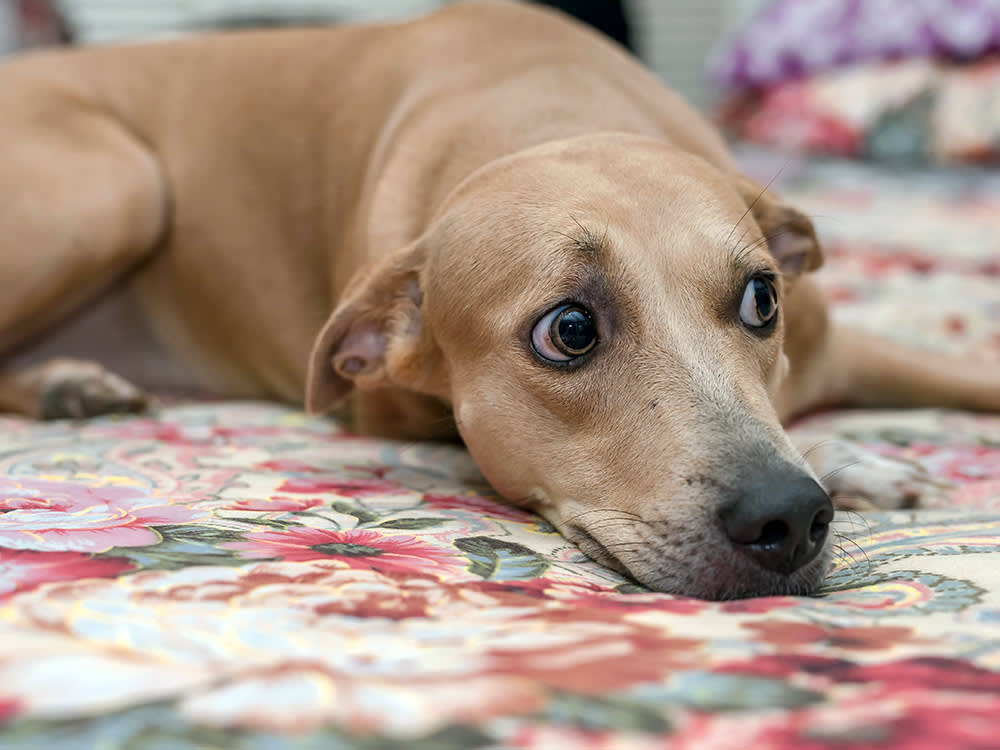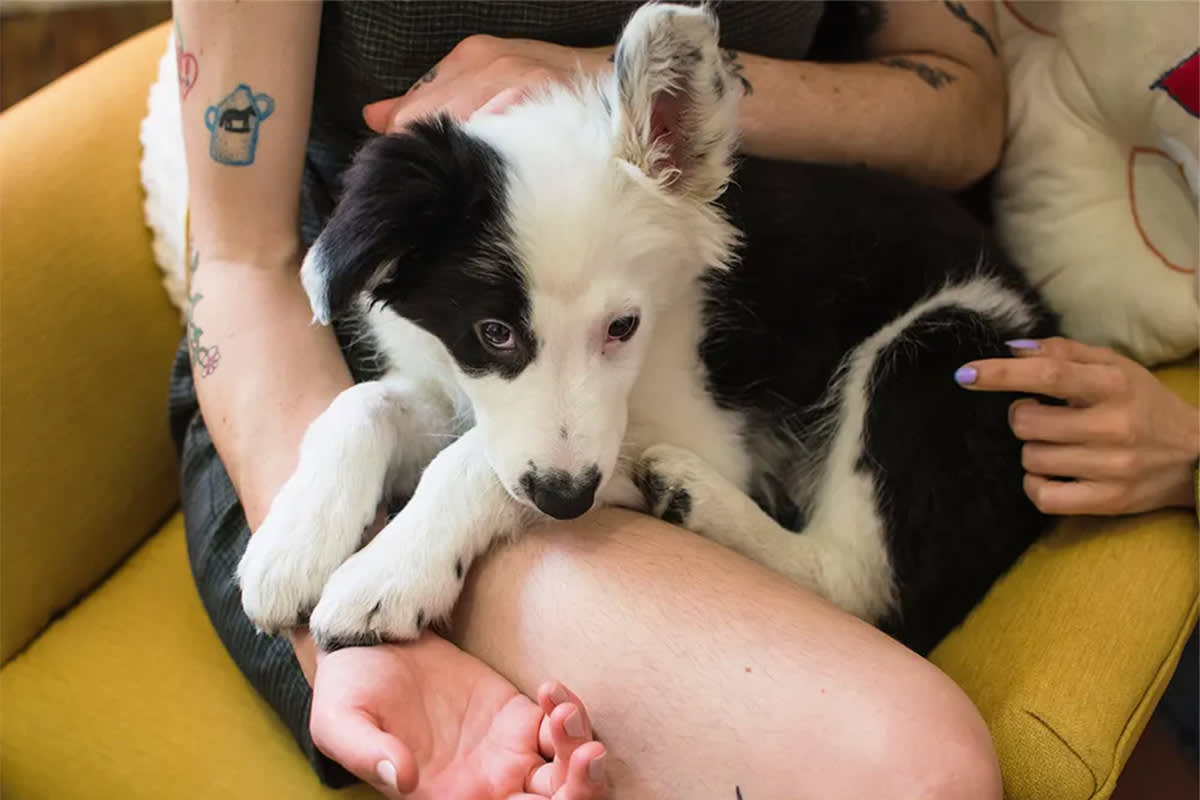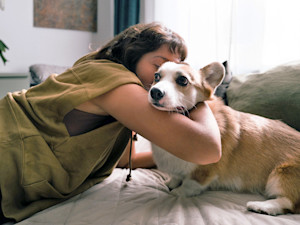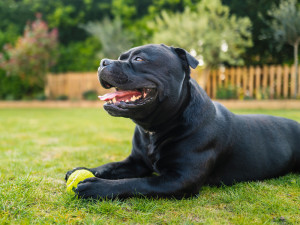Why Your Dog Seems to Remember Every Little Thing That’s Scared Them
“Fear memories” are very real for pups.

Share Article
It’s the kind of thing that can make you feel like the worst pet parent in the world: one minute, you’re minding your own business on a dog walk, and the next, your pup is shaking. Maybe you didn’t notice the lawn mower droning in the background, but they sure did — and every day after that, they seem to cower in the exact same spot.
Doggie trauma can be devastating to witness. When left to cope alone, our dogs can become avoidant, skittish, and reactive. But do they really remember every bad thing that’s ever happened to them, or are some scary moments small enough to sleep off?
Rest assured, our dogs don’t keep a running list of every hair-raising experience they’ve ever had. With some exceptions, they’ve probably forgotten the time you dropped your keys in front of them. Still, depending on the experience, you might find that your pup has more trouble shaking it off than you do. Sometimes, they need our help before they can move on.
Do dogs remember things that scared them in the past?
Definitely, but not always. It depends on several factors like the severity of the incident and your dog’s age.
How much do you spend on your pet per year?

Even seemingly ordinary events can create a “fear memory” for dogs who are startled enough. According to veterinary psychiatrist Dr. Rachel Malamedopens in new tab, associative learning leads dogs to form connections between two events, experiences, or stimuli, which can produce what’s called a “conditioned emotional response.”
“For example,” Dr. Malamed says, “a dog may initially react fearfully to loud fireworks. Later, that same dog may begin to show a fear response to darkness, simply because darkness was present during the fireworks event.” Once our dogs form these negative associations, Dr. Malamed adds, “a fear response can be triggered, even when the original threat is no longer present.”
What separates a bad memory from a traumatic one?
Just because your dog had a rough moment doesn’t mean they’ll be traumatized for life. The aftereffects will come down to the individual and the incident.
Genetics and personality
Some dogs are easier to spook than others, and that will shape how long certain events stick in their memories.
“Some dogs are just confident, happy-go-lucky,” says behavior consultant Robert Haussman , co-founder of Dogboy NYCopens in new tab. “They’re barreling through life. They shake it off like, ‘The keys fell. What are you gonna do?’” Other dogs, on the other hand, might avoid being in that space or around the person who dropped them out of fear it will happen again.
Intensity of the triggering incident
It’s not just the intensity of the event that matters — it’s how we respond.
According to Kevin Price, owner of The Missing Peace Dog Trainingopens in new tab, mammals tend to be less scarred by frightening events that they can understand. “If it’s a total surprise, a jump scare kind of thing — we're coming around a corner and all of a sudden there’s a dog there growling in front of our face — that’s way more intense,” Price says, “because we had no anticipation or understanding of the event that came out of nowhere.”
We humans can lessen the fear by keeping our responses as neutral as possible. “If the person freaks out, too, the dogs more likely to have a much more traumatic event,” Price says.
Past experience
If your dog has already been frightened by something, like a close call with a rowdy kid on a skateboard, they’re more likely to react next time it happens. The more the same trigger repeats itself, the more ingrained the fear response will become.
Age
Younger dogs have less life experience, so they tend to be more impressionable. Evolutionarily, Price explains, “Younger beings need to learn, ‘If that thing’s scary, I need to stay away from it.’ Older dogs have a little more experience of, ‘Oh, that was scary, but then I checked it out, and it turned out to be alright.’”
Socialization
In the dog world, “socialization” is about more than playing nicely with other creatures. It’s about being exposed to enough of the world to face it all without fear. Puppies need to form positive associations with experiences like going for walks, encountering other creatures, going to the vet, being handled, being around and inside of vehicles, and many, many other things.
“Think of early socialization as a vaccination against later fears and phobias, or trauma,” Dr. Malamed says. “How and what a dog is exposed to during this period allows them to be more resilient later in life. Dogs that are isolated during this period frequently become more fearful of specific stimuli later on.”
Dogs’ critical socialization period comes between three and 14 weeks old, with a sensitive period around 12 to 14 weeks and a secondary fear window around six to eight months. During these phases, building positive associations with the outside world is especially important for our dogs.“ If they make good associations to things, they tend to stay good,” Haussmann says. “If they make negative associations, they tend to stay bad.”
One way to form positive associations? Treats.
How can traumatic memories affect my pup?
Dogs’ responses to severely frightening memories can look a lot like PTSD in humans. “Just like soldiers coming out of war,” Price says, “those traumatic events can stick with them and affect their everyday life, not just the situation that was the scary thing.”
Conditioned fears
Whatever associations your dog carries forward from a scary incident, they will shape their responses to their environment in the future.
Avoidance
If your dog has decided that certain places, people, or activities are dangerous, they might do their best to stay away.
“You see this a lot with gates,” Haussmann says. Sometimes, a baby gate intended to keep a puppy safely out of a certain room will fall on them. In these cases, Haussmann says, some dogs might perpetually hesitate before walking through. Depending on the dog and the incident, this kind of avoidance can persist for years.
Medical conditions
Sometimes, traumatic memories can affect your dog’s physical health. “Fear, anxiety, and stress can contribute to medical conditions such as inflammatory bowel disease, stress colitis, or self-injurious behavior (acral lick dermatitis),” Dr. Malamed says. Chronic stress can also impair the immune system and delay healing.
Reactivity
Don’t mistake barking or fear aggression for confidence. According to Price, who specializes in reactivity, “Most aggression reactivity is based out of fear.”
How can we help our dogs deal?
Moving slowly is key. Pay attention to your dog’s behavior and meet them where they are. “We always want to use baby steps,” Haussmann says, “to make sure that you're starting where the dog can experience things and keep it positive.”
Learn body language.
Do you know what it looks like if your pup is stressed? If not, learning dog body language is the place to start. (It’s not just about whether or not their tail is wagging.)
Manage the environment.
If you already know what frightens your dog, examine your environment and daily habits to limit exposure as much as possible.
Avoid “flooding.”
“Flooding” is when we throw our pups into the metaphorical deep end and expect them to overcome their fears overnight. (Spoiler alert: They can’t.) This can look like dragging them toward something they’re afraid of, forcing them into situations they don’t like, or making them socialize even if they hesitate.
Don’t punish fear.
If your dog refuses to do what you want, don’t assume they’re acting out. “Fearful behavior isn’t disobedience — it’s a physiological and emotional response,” Dr. Malamed says. Punishment, yelling, and force can erode your dog’s trust in you and make them even more afraid.
Rebuild slowly.
Desensitization and counterconditioning can help our dogs adjust their emotional state and responses. As Price puts it, these practices teach our dogs, “I know you thought that thing was scary, but you’re misinformed.”
Small steps are key. For some minor triggers, Haussmann says, your dog might approach on their own if given the time to ease their nerves. “But if you pull them towards it, you can create trauma. You can make it something where they're like, ‘This is the gauntlet of doom, and I have no choices.’” That’s where reactivity can set in.
Keep high-value treats or toys on hand to reward your dog for calm behavior and ease fear-inducing situations. If your dog sees a person, critter, or object that normally scares them, Dr. Malamed says, make the situation more predictable by giving them a cue or offering a treat right away. If your pup won’t take the treat, that’s a sign they’re too stressed.
When should I see a vet?
If your dog seems traumatized, seek help as early as possible. The worse the fear gets, the harder it is to address.
Some dogs might benefit from medication on top of behavior modification and environmental management. That could be situational anti-anxiety medication for specific triggers, or daily medication to relieve ongoing fear and stress.
Mindset matters here as well. As Dr. Malamed puts it, “Addressing trauma isn’t just about teaching obedience or cues — it’s about helping the dog feel safe and changing their underlying emotional state.”

Laura Bradley
Laura is a New York-based experienced writer and mom of two rescue pups. Her work has appeared in Slate, Vanity Fair, Daily Beast, The Washington Post, The Atlantic, Yahoo! News, Vulture, Grazia Magazine, and more. When she is not writing or walking the pooches, you will probably find her in the community garden.
Related articles
![Puppy hides under the couch in fear]()
How to Keep Your Dog From Freaking Out When You Have Company
Do these things to help your pup (and your guests) feel chill.
![Woman trying to cuddle her dog at home.]()
Here’s Why Your Dog Doesn’t Like to Cuddle
Not everyone’s love language is touch.
![Staffordshire Bull Terrier panting on grass in profile holding a tennis ball.]()
Why Is Your Dog Breathing Heavy?
Don’t panic, but definitely talk to your vet if you’re worried about any of these conditions.
![Russian Toy Terrier with ears back]()
9 Reasons Why Dogs Put Their Ears Back
Here’s how your dog’s ears can clue you in to how they’re feeling.
Do Dogs Experience Anxiety?
No one—especially your pup—likes that uneasy feeling.






